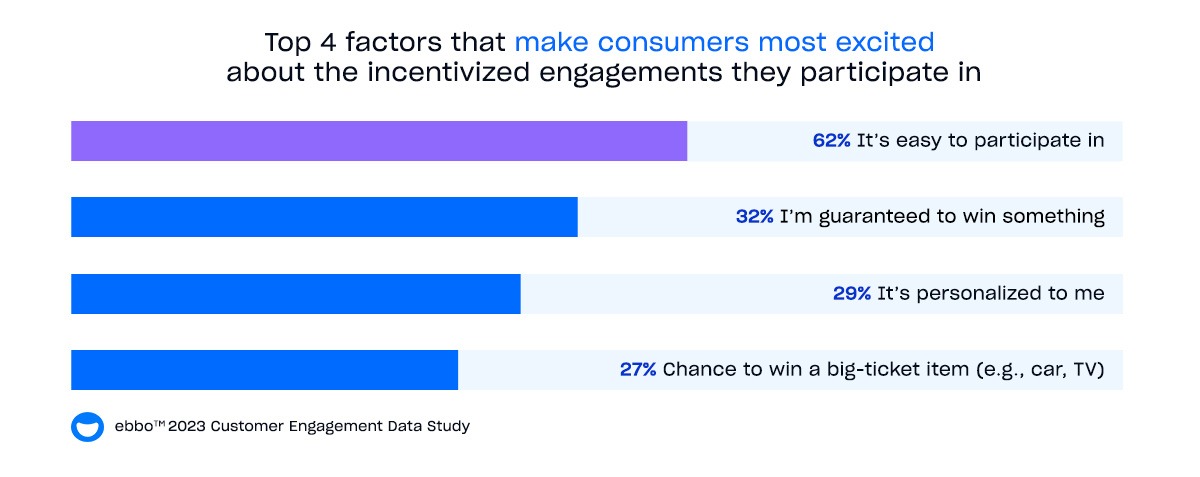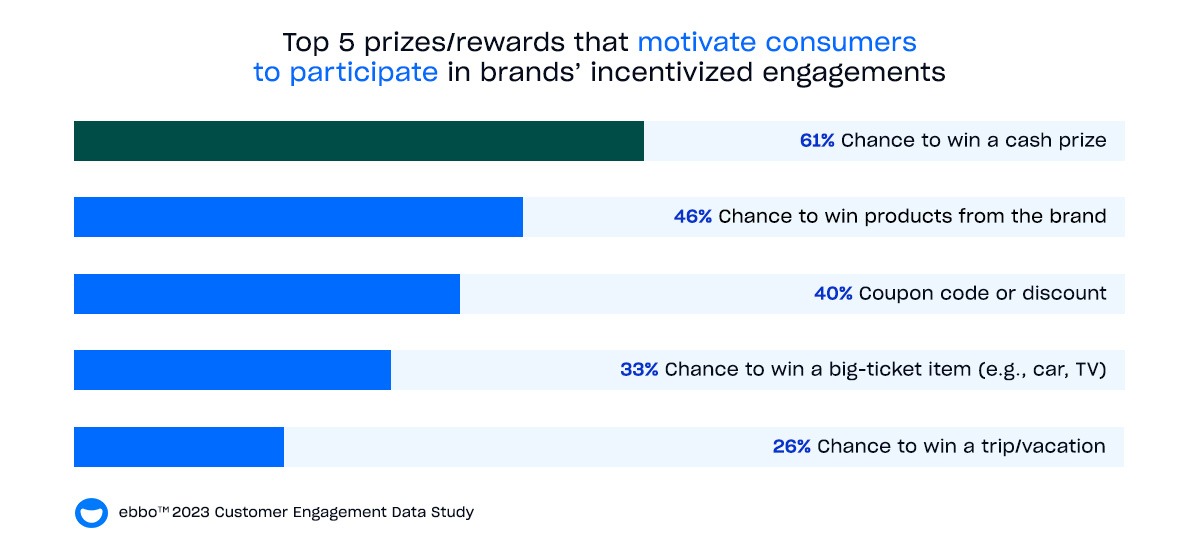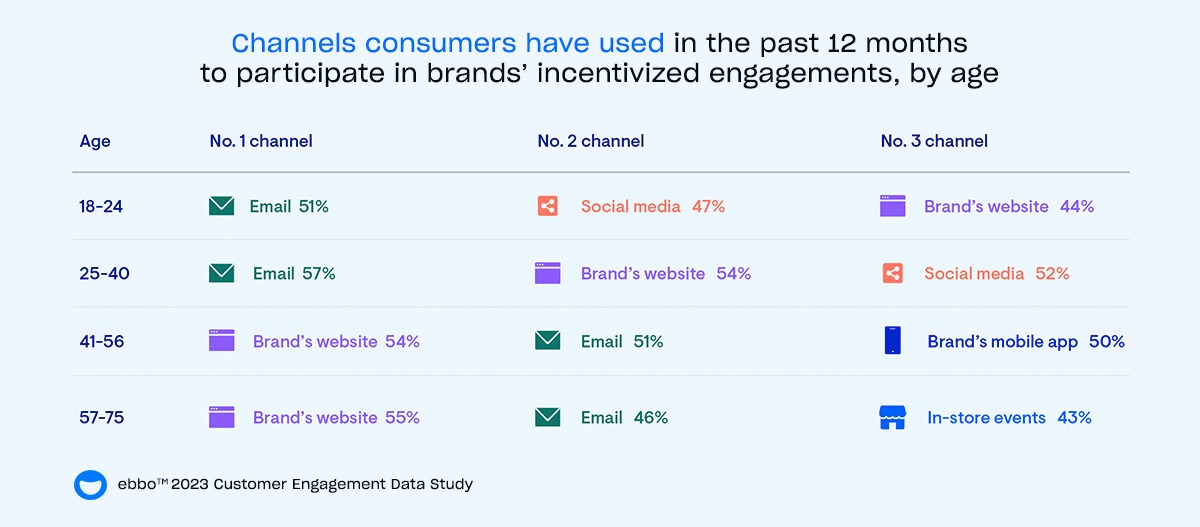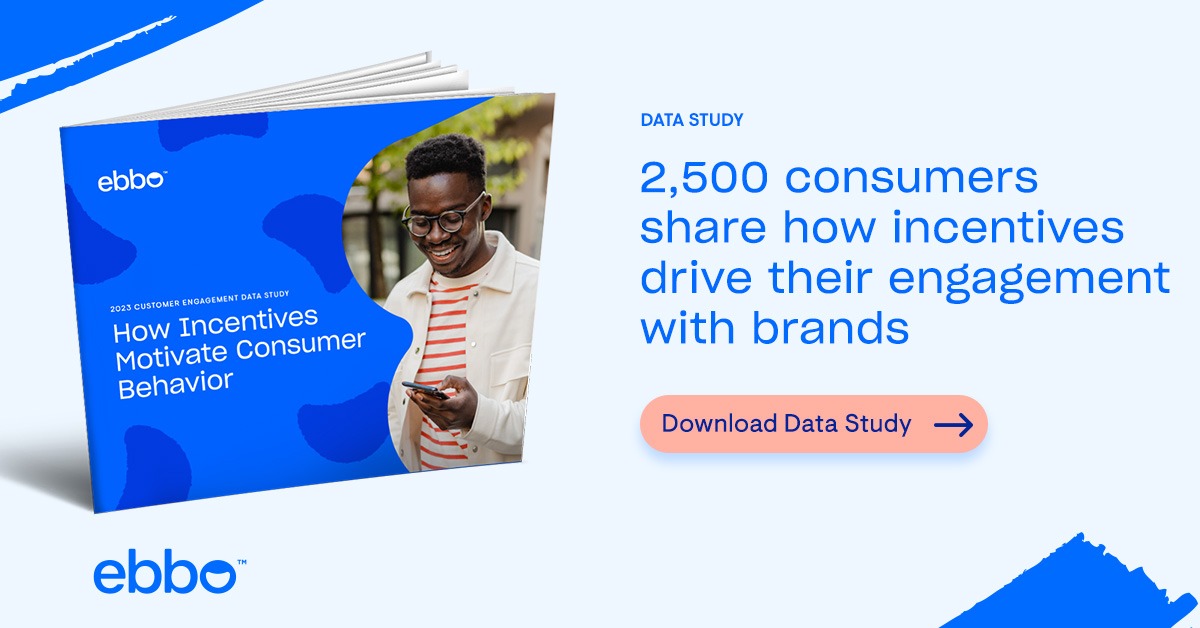What makes some incentives more appealing?
Ninety percent of consumers agree they’re more likely to engage with a brand if it offers incentivized engagements. Loyalty amplifiers elevate engagement and keep your program members coming back for more.
Here’s how you can use them stand to make your loyalty program stand out from the competition.
What Makes a Loyalty Program Stand Out?
To understand customer engagement as it relates to loyalty amplifiers, brands must analyze why consumers are willing to engage with their loyalty programs.

According to our 2023 Customer Engagement Data Study, by far, the No. 1 factor that motivates engagement is the ease of participation (62%). You can have the most perfectly designed incentive, but if it isn’t easy for consumers to participate, it won’t be successful.
The next biggest factor that makes consumers excited to participate in an incentivized engagement is they’re guaranteed to win something (32%).
Given numerous consumer options in a crowded marketplace, brands realize that shoppers are more particular than ever before. So, what makes an incentivized engagement as part of a loyalty program enticing?
Convenience and guaranteed wins mean more to consumers than emotional motivators, according to the study.
Here are some other keys to make your incentives stand out among your loyalty program members.
Relevance: The incentive should be relevant to the customer’s interests and needs. For example, if you’re selling shoes, a discount on a new pair of sneakers would be more relevant to your customers than a discount on a new car.
Value: The incentive should be valuable to the customer. This doesn’t necessarily mean it has to be expensive. A small gift card or a free shipping offer can be just as valuable to a customer as a large discount.
Affordability: The incentive should be affordable for your business. You don’t want to offer an incentive that will cost you more money than you’re making from it.
Exclusivity: The incentive should be exclusive, meaning that only a limited number of customers can get it. This will create a sense of urgency and make customers more likely to take action.
Personalization: The incentive should be personalized to the individual customer. This could mean offering a discount based on their past purchases or giving them a gift that is relevant to their interests.
Ease of use: The incentive should be easy for customers to redeem because if it’s too complicated, they’re less likely to engage.
Transparency: The incentive should be transparent. Customers should know what they need to do to earn the reward and how they can redeem it.
Creativity: The incentive should be creative and unique. This will help it stand out from other brands’ incentives and make it more memorable for customers.
Timing: The incentive should be offered at the right time. For example, you might offer a discount during a holiday season or an incentive for a new product launch.
Set clear and achievable goals for your campaign. What do you want to achieve with the campaign? Do you want to increase brand awareness, generate leads or drive sales?
Market and promote the campaign widely to reach as many people as possible. Use social media, email marketing and other channels to get the word out about the campaign.
Track your results and this will help you determine if the campaign is successful and if any changes should be made.

Product Giveaways and Discounts Motivate Consumers to Participate
While cash is the No. 1 motivator for consumers to participate in a brand’s incentivized engagement (61%), product giveaways (46%) and discounts (40%) are close behind in second and third, respectively.
Brands should consider these stats when creating incentivized engagements because consumers want product giveaways and discounts.
Cash will always be the greatest motivator, according to the study, but it doesn’t impact differentiation in the marketplace or speak to any brand values. Cash rewards are appealing, but don’t help tell your brand story and create loyal customers.
Offering brand currency within your mobile app is a great way to strengthen connections with your loyalty program members.
If you offer incentives like product giveaways and discounts, these are likely to increase repeat engagement among your loyalty program members.
Loyalty Amplifiers Help You Incentivize Engagement
Loyalty amplifiers boost engagement and drive desired behaviors. They can help your brand in many ways, such as:
- Acquiring new members: Loyalty amplifiers can be used to attract new customers to your program by offering them exclusive rewards or experiences. For example, you could offer a free gift or discount to new members who sign up for your program.
- Onboarding and educating members: Loyalty amplifiers can be used to help new members learn about your program and how to earn and redeem rewards. For example, you could offer a welcome video that explains your program.
- Increasing sales: Loyalty amplifiers can be used to encourage members to spend more money at your business. For example, you could offer a points bonus for making a large purchase or a discount on a specific product or service.
- Driving point burn: Loyalty amplifiers can be used to encourage members to redeem their points for rewards. For example, you could offer a limited-time sale on rewards or a double points promotion.
- Retaining members: Loyalty amplifiers can be used to keep members engaged and coming back for more. For example, you could offer birthday rewards, surprise and delight gifts or exclusive access to events or products.
- Fostering brand advocacy: Loyalty amplifiers can be used to turn members into brand advocates who promote your business to their friends and family. For example, you could offer referral rewards or social media contests.

Where Do Engagements Happen?
If you understand why and where consumers will engage with your loyalty amplifiers, then you can create personalized experiences based on member demographics.
So, where do consumers prefer to see incentivized engagements offered? According to the study, consumers who have participated in a brand’s incentivized engagement in the past 12 months prefer the following channels:
- A brand’s website (52%)
- Email (51%)
- A brand’s mobile app (41%)
A key point the study shows is that digital engagement opportunities are more successful for brands than in-person events.
And the study reveals that channel preferences vary by demographics such as age. For example, younger consumers are more willing to engage with brands via social media while older consumers are more likely to engage via a brand’s website.
Make Sure Your Incentives Are Engaging
Offering incentivized engagements through your loyalty program is an excellent strategy to retain members for the long run. Remember to make them easy for consumers to participate in and offer product giveaways and discounts to align with your brand values. And target your loyalty program members based on their channel preferences, which vary by age.
